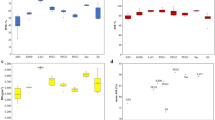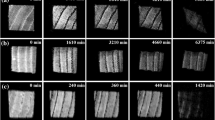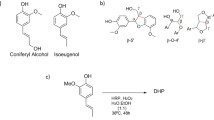Abstract
This work follows a previous one dealing with the state of conservation study of the wooden part of the roman Acqualadroni rostrum soon after its finding in the seabed of Acqualadroni (Messina, Italy). The archaeological survey and recovery were particularly relevant since this artefact is one of the two rostrums, nowadays known, found together with its wooden part. Following the recovery, it was consolidated by immersion in a melamine-formaldehyde resin (Kauramin) aqueous solution for eight months at the “Centro di Restauro del Legno Bagnato” (Pisa, Italy). The present investigation is aimed to determine at microscopic scale the wood state of conservation and to highlight interactions of the consolidant with wood components, by using solid-state NMR spectroscopy ten years after the consolidation treatment. Sampling by coring was exceptionally authorized, and the wood core was divided into seven aliquots as a function of depth. 13C cross-polarization magic angle spinning (13C{1H} CP-MAS NMR) spectra and variable contact time (VCT) experiments have been carried out to determine the cellulose crystallinity index, the lignin condensation degree and the holocellulose-lignin ratio. The interactions between the resin and the wood components were highlighted by T1ρH relaxation times determination and two-dimensional 13C–1H correlation (FSLG CP HETCOR) NMR experiments. Findings revealed specific interactions between the aromatic part of the resin and the lignin, as well as a network of hydrogen bonds involving all components of the system.
Graphic abstract









Similar content being viewed by others
References
Aliev AE (2005) Solid-state NMR studies of collagen-based parchments and gelatin. Biopolymers 77:230–245
Bardet M, Foray MF, Trân QK (2002) High-resolution solid-state CPMAS NMR study of archaeological woods. Anal Chem 74:4386–4390
Bardet M, Gerbaud G, Doan C, Giffard M, Hediger S, De Paëpe G, Trân QK (2012) Dynamics property recovery of archaeological-wood fibers treated with polyethylene glycol demonstrated by high-resolution solid-state NMR. Cellulose 19:1537–1545
Bardet M, Gerbaud G, Giffard M, Doan C, Hediger S, Le Pape L (2009) 13C high-resolution solid-state NMR for structural elucidation of archaeological woods. Prog Nucl Mag Res Sp 55:199–214
Bardet M, Gerbaud G, Trân QK, Hediger S (2007) Study of interactions between polyethylene glycol and archaeological wood components by 13C high-resolution solid-state CP-MAS NMR. J Archaeol Sci 34:1670–1676
Bastone S, Spinella A, Chillura Martino DF, Tusa S, Caponetti E (2016) More insight into characterization of the waterlogged wooden part of Acqualadroni Roman Rostrum by solid-state NMR. Microchem J 124:831–836
Bastone S, Spinella A, Romagnoli M, Buccellato M, Caponetti CAE (2011) Solid state NMR characterization of the waterlogged wooden part of Acqualadrone roman rostrum. In: IA-CS (ed) Contribute and role of youth on conservation of cultural heritage, 1st edn. Roma, pp 49–58
Blanchette RA, Haight JE, Koestler RJ, Hatchfield PB, Arnold D (1994) Assessment of deterioration in archaeological wood from ancient Egypt. J Am Inst Conserv 33:55–70
Broda M, Mazela B (2017) Application of methyltrimethoxysilane to increase dimensional stability of waterlogged wood. J Cult Herit 25:149–156
Campanella L et al (2007) Chimica per L’arte. Zanichelli, Bologna
Capitani D, Proietti N, Ziarelli F, Segre AL (2002) NMR study of water-filled pores in one of the most widely used polymeric material: the paper. Macromolecules 35:5536–5543
Caruso F, Saladino ML, Spinella A, Di Stefano C, Tisseyre P, Tusa S, Caponetti E (2011) Physico-chemical characterization of the Acqualadrone Rostrum. Archaeometry 53:547–562
Cavallaro G, Lazzara G, Milioto S, Parisi F (2018a) Halloysite nanotubes for cleaning, consolidation and protection. Chem Rec 18:940–949
Cavallaro G, Milioto S, Parisi F, Lazzara G (2018b) Halloysite nanotubes loaded with calcium hydroxide: alkaline fillers for the deacidification of waterlogged archeological woods. ACS Appl Mater Interfaces 10:27355–27364
Cesar T, Danevčič T, Kavkler K, Stopar D (2017) Melamine polymerization in organic solutions and waterlogged archaeological wood studied by FTIR spectroscopy. J Cult Herit 23:106–110
Chierotti MR, Gobetto R (2013) NMR crystallography: the use of dipolar interactions in polymorph and co-crystal investigation. CrystEngComm 15:8599–8612
Crisci GM, Russa MF, Malagodi M, Ruffolo SA (2010) Consolidating properties of Regalrez 1126 and Paraloid B72 applied to wood. J Cult Herit 11:304–308
Dwainto W, Inoue M, Norimoto M (1997) Fixation of deformation of wood by heat treatment. Makuzai Gakkaishi 43:303–309
Fantazzini P, Maccotta A, Gombia M, Garavaglia C, Brown RJS, Brai M (2006) Solid–liquid nuclear magnetic resonance relaxation and signal amplitude relationships with ranking of seasoned softwoods and hardwoods. J Appl Phys. 100:074907-1–074907-6
Fiesoli F, Gennai F (2010) Trattamenti conservativi per il restauro di materiali organici imbibiti d’acqua. Gradus 5:9–16
Frank P, Caruso F, Caponetti E (2012) Ancient wood of the Acqualadrone Rostrum: materials history through gas chromatography/mass spectrometry and sulfur X-ray absorption. Spectrosc Anal Chem 84:4419–4428
Gilardi G, Abis L, Cass AEG (1995) Carbon-13 CP/MAS solid-state NMR and FT-IR spectroscopy of wood cell wall biodegradation. Enzyme Microb Technol 17:268–275
Hatcher PG (1988) Dipolar-dephasing 13C NMR studies of decomposed wood and coalified xylem tissue: evidence for chemical structural changes associated with defunctionalization of lignin structural units during coalification. Energy Fuel 2:48–58
Haw JF, Maciel GE, Schroeder HA (1984) Carbon-13 nuclear magnetic resonance spectrometric study of wood and wood pulping with cross polarization and magic-angle spinning. Anal Chem 56:1323–1329
Kennedy CJ, Cameron GJ, Šturcová A et al (2007) Microfibril diameter in celery collenchyma cellulose: X-ray scattering and NMR evidence. Cellulose 14:235–246
Kim YS, Singh AP, R.Funada R (2016) Secondary xylem biology. Origins, functions, and application, 1st edn. Elsevier, Amsterdam, pp 233–257
Lau C, Mi Y (2002) A study of blending and complexation of poly (acrylic acid)/poly(vinyl pyrrolidone). Polymer 43:823–829
Lee EC, Hong BH, Lee JY, Kim JC, Kim D, Kim Y, Tarakeshwar P, Kim KS (2005) Substituent effects on the edge-to-face aromatic interactions. J Am Chem Soc 127:4530–4537
Li R, Zhang Z, Liu G, Han X, Pu J (2018) Inserting poly(ε-caprolactone) into wood cell wall structures for dehydration and consolidation of waterlogged scots pine wood. BioResources 13:881–893
Liitiä T, Maunu SL, Sipilä J, Hortling B (2002a) Application of solid-state 13C NMR spectroscopy and dipolar dephasing technique to determine the extent of condensation in technical lignins. Solid State Nucl Magn Reson 21:171–186
Liitiä T, Maunu SL, Sipilä J, Hortling B (2002b) Application of solid-state 13C NMR spectroscopy and dipolar dephasing technique to determine the extent of condensation in technical lignins. Solid State Nucl Magn Reson 21:171–186
Łucejko JJ, Zborowska M, Modugno F, Colombini MP, Pradzynski W (2012) Analytical pyrolysis vs. classical wet chemical analysis to assess the decay ofarchaeological waterlogged wood. Anal Chim Acta 745:70–77
Macchioni N, Pizzo B, Capretti C, Giachi G (2012) How an integrated diagnostic approach can help in a correct evaluation of the state of preservation of waterlogged archaeological wooden artefacts. J Archaeol Sci 39:3255–3263
McHale E, Steindal CC, Kutzke H, Benneche T, Harding SE (2017) In situ polymerisation of isoeugenol as a green consolidation method for waterlogged archaeological wood. Sci Rep. https://doi.org/10.1038/srep46481
Modica A, Rosselli S, Catinella G, Sottile F, Catania CA, Cavallaro G, Lazzara G, Botta L, Spinella A, Bruno M (2020) Solid state 13C-NMR methodology for the cellulose composition studies of the shells of Prunus dulcis and their derived cellulosic materials. Carbohydr Polym 240:116290. https://doi.org/10.1016/j.carbpol.2020.116290
Newman RH (2004) Homogeneity in cellulose crystallinity between samples of Pinus radiata wood. Holzforschung 58:91–96
Nishida M, Tanaka T, Miki T, Hayakawa Y, Kanayama K (2019) Integrated analysis of modified Japanese cypress using solid-state NMR spectra and nuclear magnetic relaxation times. Cellulose 26:3625–3642
Pecoraro E, Pizzo B, Salvini A, Macchioni N (2019) Dynamic mechanical analysis (DMA) at room temperature of archaeological wood treated with various consolidants. Holzforschung 72:757–772
Poggi G, Toccafondi N, Chelazzi D, Canton P, Giorgi R, Baglioni P (2016) Calcium hydroxide nanoparticles from solvothermal reaction for the deacidification of degraded waterlogged wood. J Colloid Interface Sci 473:1–8
Radloff D, Boeffel C, Spiess HW (1996) Cellulose and cellulose/poly(vinyl alcohol) blends. 2. Water organization revealed by solid-state NMR spectroscopy. Macromolecules 29:1528–1534
Sinnokrot MO, Sherrill CD (2004) Substituent effects in π–π interactions: sandwich and T-shaped configurations. J Am Chem Soc 126:7690–7697
Spinella A, Malagodi M, Saladino ML, Weththimuni ML, Caponetti E, Licchelli M (2017) A step forward in disclosing the secret of Stradivari’s varnish by NMR spectroscopy. J Polym Sci Part A 55:3949–3954
Steffy JR, Pomey P, Basch L, Frost H (1983) The Athlit Ram—a preliminary investigation of its structure. Mariner’s Mirror 69:3
Tisseyre P (2013) Il Rostro di Acqualadroni: un relitto del III sec. a.C. in Un Mare d’aMare, Palermo
Tohmura SI, Inoue A, Sahari SH (2001) Influence of the melamine content in melamine-urea-formaldehyde resins on formaldehyde emission and cured resin structure. Jpn Wood Res Soc 47:451–457
Wang W, Hobza P (2008) Theoretical study on the complexes of benzene with isoelectronic nitrogen-containing heterocycles. ChemPhysChem 9:1003–1009
Weiss S, Urdl K, Mayer HA, Zikulnig-Rusch E, Kandelbauer A (2019) IR spectroscopy: suitable method for determination of curing degreeand crosslinking type in melamine–formaldehyde resins. J Appl Polym Sci 136:47691–47701
Zoia L, Orlandi M, Tolppa EL, Donato DI, Agozzino P, Elegir G, Giachi G (2008) Consolidamento di legni degradati tramite polimerizzazione in situ di isoeugenolo. Gradus 3:61–68
Acknowledgments
This work is dedicated to the memory of prof. Sebastiano Tusa who died in the tragic plane crash of the Ethiopian Airlines in Bishoftu (Ethiopia).
Funding
This work is part of the project PON03PE_00214_2 (PON R&C 2007–2013) “Development and Application of Innovative Materials and processes for the diagnosis and restoration of Cultural Heritage—DELIAS” granted by MIUR—DD. n. 3266 del 5/12/2016. The funding source had no involvement for preparation of the article, in the study design, collection, analysis and interpretation of data and in the decision to submit the article for publication.
Author information
Authors and Affiliations
Corresponding author
Rights and permissions
About this article
Cite this article
Spinella, A., Chillura Martino, D.F., Saladino, M.L. et al. Solid state NMR investigation of the roman Acqualadroni rostrum: tenth year assessment of the consolidation treatment of the wooden part. Cellulose 28, 1025–1038 (2021). https://doi.org/10.1007/s10570-020-03563-2
Received:
Accepted:
Published:
Issue Date:
DOI: https://doi.org/10.1007/s10570-020-03563-2




